A) immediately after the price increase
B) one month after the price increase
C) three months after the price increase
D) one year after the price increase
Correct Answer

verified
Correct Answer
verified
Multiple Choice
Income elasticity of demand measures how
A) the quantity demanded changes as consumer income changes.
B) consumer purchasing power is affected by a change in the price of a good.
C) the price of a good is affected when there is a change in consumer income.
D) many units of a good a consumer can buy given a certain income level.
Correct Answer

verified
Correct Answer
verified
Multiple Choice
Figure 5-5 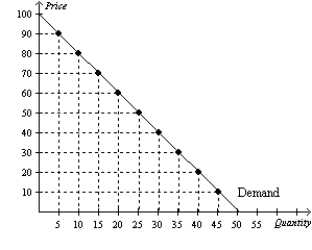 -Refer to Figure 5-5.Using the midpoint method,between prices of $20 and $30,price elasticity of demand is about
-Refer to Figure 5-5.Using the midpoint method,between prices of $20 and $30,price elasticity of demand is about
A) 0.33.
B) 0.4.
C) 1.33.
D) 3.
Correct Answer

verified
Correct Answer
verified
Multiple Choice
Studies indicate that the price elasticity of demand for cigarettes is about 0.4.A government policy aimed at reducing smoking changed the price of a pack of cigarettes from $2 to $6.According to the midpoint method,the government policy should have reduced smoking by
A) 30%.
B) 40%.
C) 80%.
D) 250%.
Correct Answer

verified
Correct Answer
verified
Multiple Choice
Food and clothing tend to have
A) small income elasticities because consumers,regardless of their incomes,choose to buy relatively constant quantities of these goods.
B) small income elasticities because consumers buy proportionately more of both goods at higher income levels than they buy at low income levels.
C) large income elasticities because they are necessities.
D) large income elasticities because they are relatively inexpensive.
Correct Answer

verified
Correct Answer
verified
Multiple Choice
When demand is perfectly inelastic,the demand curve will be
A) negatively sloped,because buyers decrease their purchases when the price rises.
B) vertical,because buyers purchase the same amount as before whenever the price rises or falls.
C) positively sloped,because buyers increase their purchases when price rises.
D) positively sloped,because buyers increase their total expenditures when price rises.
Correct Answer

verified
Correct Answer
verified
Multiple Choice
Figure 5-12 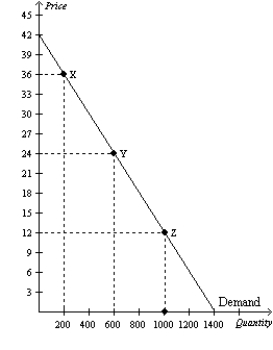 -Refer to Figure 5-12.Using the midpoint method,the price elasticity of demand between point X and point Y is
-Refer to Figure 5-12.Using the midpoint method,the price elasticity of demand between point X and point Y is
A) 0.4.
B) 1.
C) 2.
D) 2.5.
Correct Answer

verified
Correct Answer
verified
Multiple Choice
How does total revenue change as one moves downward and to the right along a linear demand curve?
A) It always increases.
B) It always decreases.
C) It first increases,then decreases.
D) It is unaffected by a movement along the demand curve.
Correct Answer

verified
Correct Answer
verified
Multiple Choice
Figure 5-4 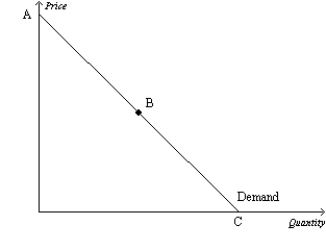 -Refer to Figure 5-4.Assume,for the good in question,two specific points on the demand curve are (Q = 2,000,P = $15) and (Q = 2,400,P = $12) .Then which of the following scenarios is possible?
-Refer to Figure 5-4.Assume,for the good in question,two specific points on the demand curve are (Q = 2,000,P = $15) and (Q = 2,400,P = $12) .Then which of the following scenarios is possible?
A) Both of these points lie on section BC of the demand curve.
B) The vertical intercept of the demand curve is the point (Q = 0,P = $22) .
C) The horizontal intercept of the demand curve is the point (Q = 5,000,P = $0) .
D) Any of these scenarios is possible.
Correct Answer

verified
Correct Answer
verified
Multiple Choice
Figure 5-5  -Refer to Figure 5-5.Using the midpoint method,between prices of $70 and $80,price elasticity of demand is
-Refer to Figure 5-5.Using the midpoint method,between prices of $70 and $80,price elasticity of demand is
A) 0.33.
B) 0.4.
C) 1.33.
D) 3.
Correct Answer

verified
Correct Answer
verified
Multiple Choice
Demand is said to be unit elastic if quantity demanded
A) changes by the same percent as the price.
B) changes by a larger percent than the price.
C) changes by a smaller percent than the price.
D) does not respond to a change in price.
Correct Answer

verified
Correct Answer
verified
Multiple Choice
Figure 5-1 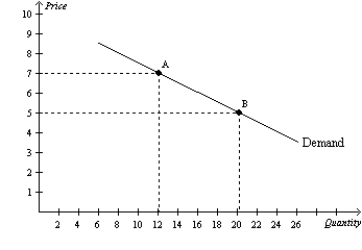 -Refer to Figure 5-1.Between point A and point B on the graph,demand is
-Refer to Figure 5-1.Between point A and point B on the graph,demand is
A) perfectly elastic.
B) inelastic.
C) unit elastic.
D) elastic,but not perfectly elastic.
Correct Answer

verified
Correct Answer
verified
Multiple Choice
Figure 5-12  -Refer to Figure 5-12.Sellers' total revenue would increase if the price
-Refer to Figure 5-12.Sellers' total revenue would increase if the price
A) increased from $12 to $15.
B) decreased from $39 to $36.
C) decreased from $27 to $24.
D) All of the above are correct.
Correct Answer

verified
Correct Answer
verified
Multiple Choice
For a particular good,an 8 percent increase in price causes a 4 percent decrease in quantity demanded.Which of the following statements is most likely applicable to this good?
A) There are many close substitutes for this good.
B) The good is a luxury.
C) The market for the good is broadly defined.
D) The relevant time horizon is long.
Correct Answer

verified
Correct Answer
verified
Multiple Choice
Last month,sellers of good Y took in $100 in total revenue on sales of 50 units of good Y.This month sellers of good Y raised their price and took in $120 in total revenue on sales of 40 units of good Y.At the same time,the price of good X stayed the same,but sales of good X increased from 20 units to 40 units.We can conclude that goods X and Y are
A) substitutes,and have a cross-price elasticity of 0.60.
B) complements,and have a cross-price elasticity of -0.60.
C) substitutes,and have a cross-price elasticity of 1.67.
D) complements,and have a cross-price elasticity of -1.67.
Correct Answer

verified
Correct Answer
verified
Multiple Choice
Figure 5-5  -Refer to Figure 5-5.At a price of $70 per unit,sellers' total revenue equals
-Refer to Figure 5-5.At a price of $70 per unit,sellers' total revenue equals
A) $700.
B) $1050.
C) $1250.
D) $1400.
Correct Answer

verified
Correct Answer
verified
Multiple Choice
Suppose that when the price of good X falls from $10 to $8,the quantity demanded of good Y rises from 20 units to 25 units.Using the midpoint method,the cross-price elasticity of demand is
A) -1.0,and X and Y are complements.
B) -1.0,and X and Y are substitutes.
C) 1.0,and X and Y are complements.
D) 1.0,and X and Y are substitutes.
Correct Answer

verified
Correct Answer
verified
Multiple Choice
For which of the following goods is the income elasticity of demand likely lowest?
A) water
B) sapphire pendant necklaces
C) filet mignon steaks
D) fresh fruit
Correct Answer

verified
Correct Answer
verified
Multiple Choice
Using the midpoint method,the price elasticity of demand for a good is computed to be approximately 0.75.Which of the following events is consistent with a 10 percent decrease in the quantity of the good demanded?
A) a 7.5 increase in the price of the good
B) a 13.33 percent increase in the price of the good
C) an increase in the price of the good from $7.50 to $10
D) an increase in the price of the good from $10 to $17.50
Correct Answer

verified
Correct Answer
verified
Multiple Choice
Figure 5-8 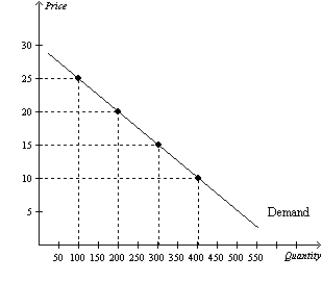 -Refer to Figure 5-8.When price falls from $25 to $20,demand is
-Refer to Figure 5-8.When price falls from $25 to $20,demand is
A) inelastic,since total revenue decreases from $4,000 to $2,500.
B) inelastic,since total revenue increases from $2,500 to $4,000.
C) elastic,since total revenue increases from $2,500 to $4,000.
D) unit elastic,since total revenue does not change.
Correct Answer

verified
Correct Answer
verified
Showing 241 - 260 of 303
Related Exams